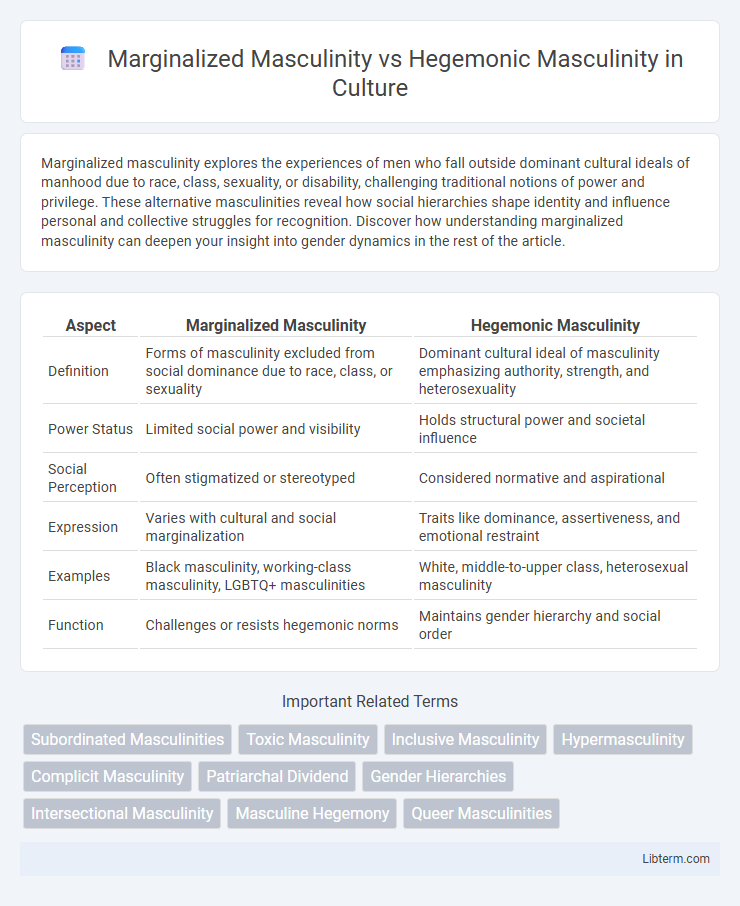Marginalized masculinity explores the experiences of men who fall outside dominant cultural ideals of manhood due to race, class, sexuality, or disability, challenging traditional notions of power and privilege. These alternative masculinities reveal how social hierarchies shape identity and influence personal and collective struggles for recognition. Discover how understanding marginalized masculinity can deepen your insight into gender dynamics in the rest of the article.
Table of Comparison
| Aspect | Marginalized Masculinity | Hegemonic Masculinity |
|---|---|---|
| Definition | Forms of masculinity excluded from social dominance due to race, class, or sexuality | Dominant cultural ideal of masculinity emphasizing authority, strength, and heterosexuality |
| Power Status | Limited social power and visibility | Holds structural power and societal influence |
| Social Perception | Often stigmatized or stereotyped | Considered normative and aspirational |
| Expression | Varies with cultural and social marginalization | Traits like dominance, assertiveness, and emotional restraint |
| Examples | Black masculinity, working-class masculinity, LGBTQ+ masculinities | White, middle-to-upper class, heterosexual masculinity |
| Function | Challenges or resists hegemonic norms | Maintains gender hierarchy and social order |
Understanding Masculinity: Definitions and Dimensions
Marginalized masculinity challenges hegemonic masculinity by representing identities excluded from dominant cultural ideals of manhood, often due to race, class, or sexuality. Hegemonic masculinity embodies the culturally exalted standards of strength, authority, and heterosexuality that maintain gender hierarchies and social dominance. Understanding masculinity requires analyzing its multiple dimensions, including power relations, social context, and the intersectionality that shapes diverse masculine experiences.
Historical Context of Hegemonic Masculinity
Hegemonic masculinity historically emerged as a dominant social construct reinforcing male authority within patriarchal societies, privileging traits such as toughness, dominance, and economic control. Rooted in Western industrialization and colonialism, it marginalized alternative masculinities by promoting a singular ideal aligned with power structures and social hierarchies. Marginalized masculinities, often linked to race, class, or sexuality, resisted and deviated from these hegemonic norms, highlighting the intersectionality inherent in gender identity.
Characteristics of Marginalized Masculinity
Marginalized masculinity is characterized by its exclusion from dominant cultural ideals of manhood due to factors such as race, class, disability, or sexuality, which limit access to power and privilege. Unlike hegemonic masculinity, which embodies societal norms of authority, strength, and heterosexuality, marginalized masculinities often emphasize resilience, adaptability, and communal bonds within marginalized groups. This form of masculinity challenges traditional gender hierarchies by existing outside dominant norms while negotiating identity in contexts shaped by social inequalities.
Intersectionality and Masculine Identity
Marginalized masculinity challenges hegemonic masculinity by highlighting how race, class, and sexuality intersect to shape diverse masculine identities that deviate from dominant norms. Intersectionality reveals how systemic inequalities influence the lived experiences of men who occupy subordinated positions within the gender hierarchy. This complex interplay underscores that masculine identity is not monolithic but is constructed through varying social, cultural, and institutional forces.
Power Dynamics Between Masculinities
Marginalized masculinity challenges hegemonic masculinity by existing outside dominant norms, often facing systemic exclusion and limited access to power. Hegemonic masculinity maintains social dominance through reinforcing traditional ideals of strength, authority, and control, marginalizing alternative masculinities in the process. Power dynamics between these masculinities reflect broader social hierarchies, where hegemonic forms legitimize their dominance by subordinating and stigmatizing marginalized masculinities.
Media Representation: Hegemonic vs Marginalized Masculinity
Media representation often reinforces hegemonic masculinity by depicting dominant, authoritative male figures as ideals, embodying traits like strength, assertiveness, and control. Marginalized masculinity, characterized by alternative gender expressions or non-conformity to traditional norms, receives limited or stereotyped portrayal, frequently resulting in invisibility or negative framing. This disparity shapes societal perceptions by upholding hegemonic masculinity as the norm while marginalizing diverse male identities.
The Impact on Mental Health and Well-being
Marginalized masculinity often results in heightened mental health challenges due to social exclusion, stress from identity conflicts, and limited access to supportive resources, which contrasts with hegemonic masculinity that promotes dominance but equally pressures men to suppress vulnerability. The internalization of hegemonic masculine norms can exacerbate issues such as depression and anxiety by discouraging emotional expression and help-seeking behavior. Understanding these dynamics is crucial for developing gender-sensitive mental health interventions that address the unique needs of men experiencing marginalization.
Socialization and Cultural Expectations
Marginalized masculinity arises from socialization processes that position certain men outside dominant cultural norms, often due to race, class, or sexuality, challenging hegemonic masculinity's ideal of authority, control, and heteronormativity. Cultural expectations enforce hegemonic masculinity through institutions like family, media, and education, promoting traits such as toughness, emotional restraint, and dominance while marginalizing alternative masculinities. These socialization patterns contribute to the power dynamics and identity formations that maintain hegemonic masculinity's privileged status while simultaneously excluding and stigmatizing marginalized masculinities.
Challenging the Dominant Masculinity Narrative
Marginalized masculinity challenges the dominant masculinity narrative by highlighting the experiences of men excluded from hegemonic ideals due to race, class, or sexuality. This perspective exposes the limitations of hegemonic masculinity, which valorizes traits like dominance, aggression, and heterosexuality, and ignores diverse masculine identities. Recognizing marginalized masculinities promotes inclusivity and critiques power structures that maintain social hierarchies based on rigid gender norms.
Pathways Toward Inclusive Masculinity
Pathways toward inclusive masculinity challenge hegemonic masculinity by promoting diverse expressions of male identity that reject dominance, aggression, and exclusion. Marginalized masculinities often emerge from social positions excluded by hegemonic norms, offering alternative frameworks centered on empathy, cooperation, and emotional vulnerability. Inclusive masculinity fosters social environments where multiple masculinities coexist without hierarchy, enabling healthier gender relations and reducing homophobia and gender-based violence.
Marginalized Masculinity Infographic

 libterm.com
libterm.com